MXA RIDES CYCRA’S JGRMX 2017 SUZUKI RM-Z450
Click on images to enlarge
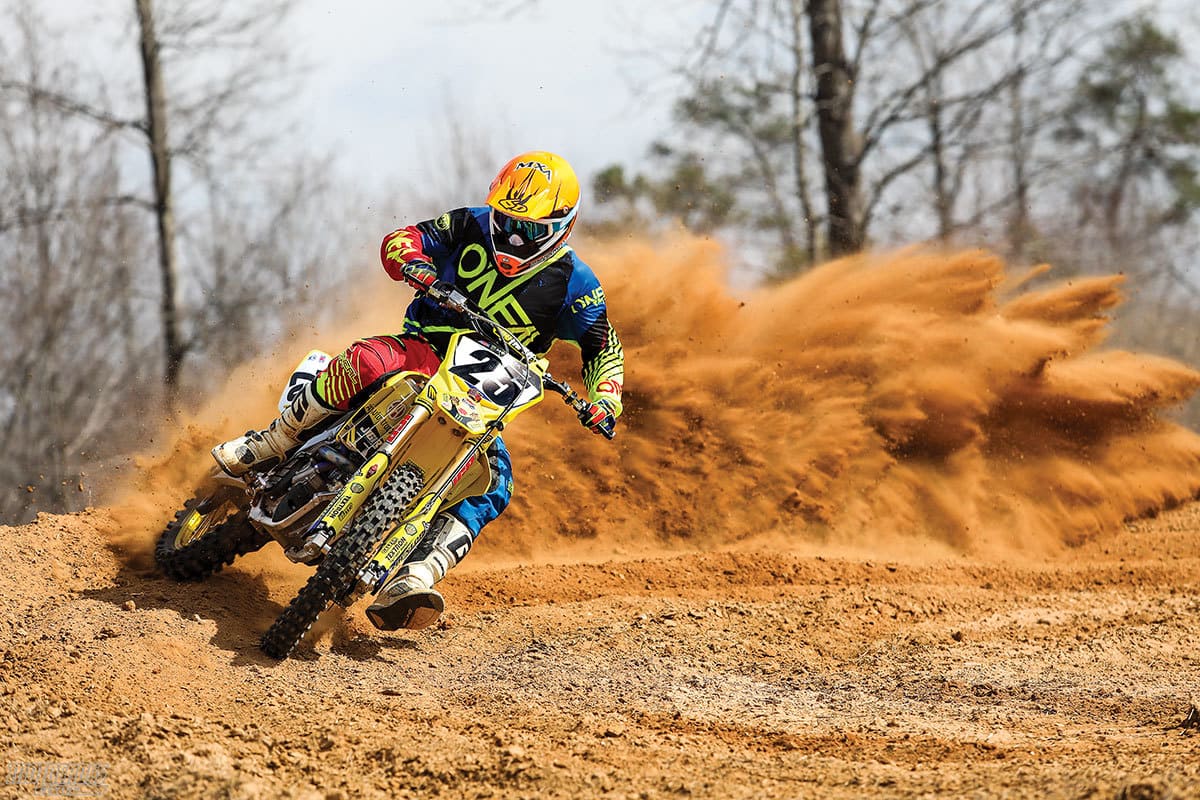
We will admit to being judgmental about the 2017 Suzuki RM-Z450. Why? Because it is virtually the same bike as the nine models that came before it. While other manufacturs have attempted to move forward over the last decade with upgrades and technological leaps, even if they were wrong, the pencil pushers at Suzuki of Japan were complacent. Only small refinements have been made over the last decade. Why? For starters, Suzuki’s understanding of what the American consumer wants has been all wrong. Instead of dumping money into developing the RM-Z450 further to keep the competition in sight, they took that money and signed big-name riders in hopes that race wins could sell machines. Suzuki didn’t hire just any factory riders. Suzuki hired the biggest names in the sport: Chad Reed, Ryan Dungey, James Stewart and Ken Roczen, just to name a few. But, none of the greatest riders in the world, or their Championships, could sell a Suzuki to a local Intermediate at Chicken Licks Raceway. What Suzuki never understood was that “product is king.” If you build it, they will come; and if you don’t build it, someone else will.
“THE MAJORITY OF PARTS, ENGINE WORK AND SUSPENSION DEVELOPMENT USED ON THE JGR SUZUKI’S ARE AVAILABLE TO THE PUBLIC THROUGH THE JGRMX STORE.”
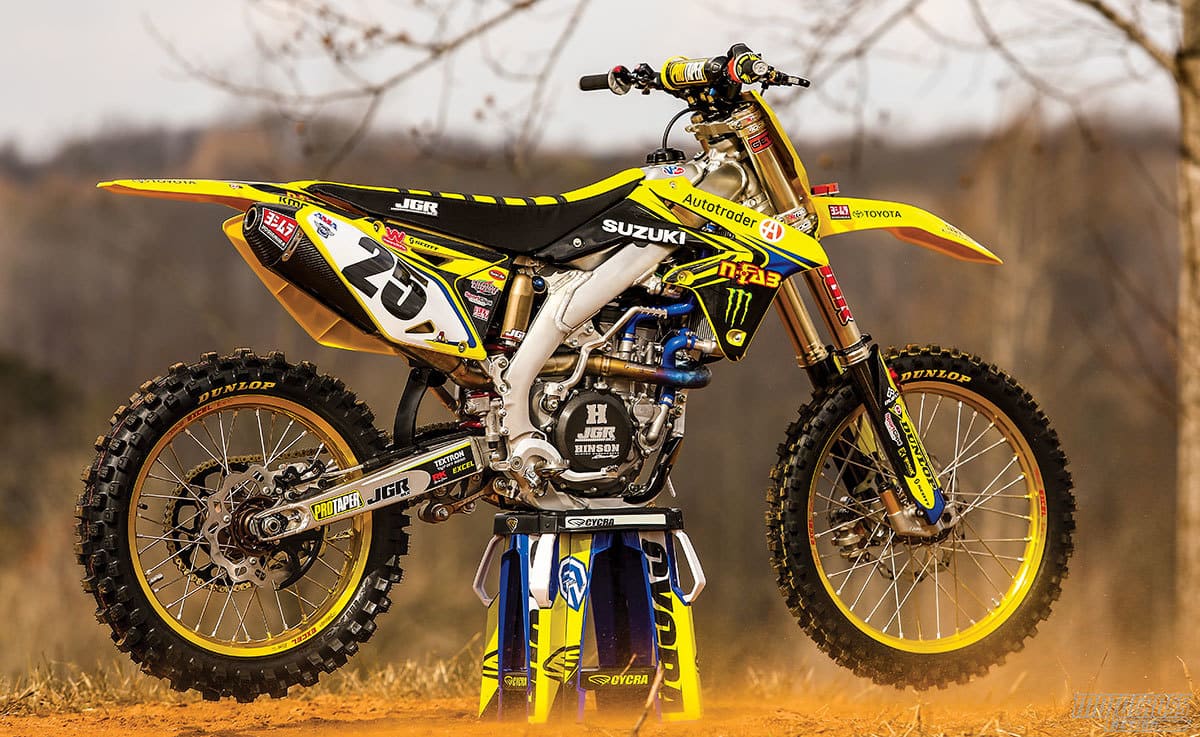
We don’t think that the 2017 Suzuki RM-Z450 is a terrible bike, although it has finished last in the “MXA 450 Shootout” for the last couple years running. The fact is, the 2017 RM-Z450 has lots of potential. Yes, it is the slowest and heaviest bike currently available, but it is also the best-turning bike in its class, has good ergos and has a nice, easy-to-ride powerband. Sadly, Suzuki hasn’t made an iota of effort to shed an ounce of the 18-pound weight penalty that it carries over the 2017 KTM 450SXF. For Suzuki to sell bikes to consumers who really care about the bikes they ride, Suzuki needs to care even more. The all-new 2018 Suzuki RM-Z450 is a step in the right direction, but it doesn’t help people who own 2017 models.
So, the MXA wrecking crew went looking for someone who did care how the 2017 Suzuki RM-Z450s ran, and, even better, had no choice but to find every ounce of potential that was hidden away in the RM-Z450. That someone was JGRMX.
At the end of 2016 season, JGRMX signed a last-minute deal to break away from long-term bike supplier Yamaha and switch to Suzuki for 2017. This kicked the JGR team into high gear to learn the ins and outs of the RM-Z450 in time to make Justin Barcia and Weston Peick not only happy but competitive. With JGR’s arsenal of engineers, engine technicians, mechanics and riders, the objective was completed in time for the start of the 2017 Supercross season.
“THE GUYS OVER AT CYCRA HAD A BRAND-SPANKING-NEW RM-Z450 ON THEIR HANDS. IT WAS DECKED OUT WITH NEW PLASTICS BUT NOTHING ELSE.”
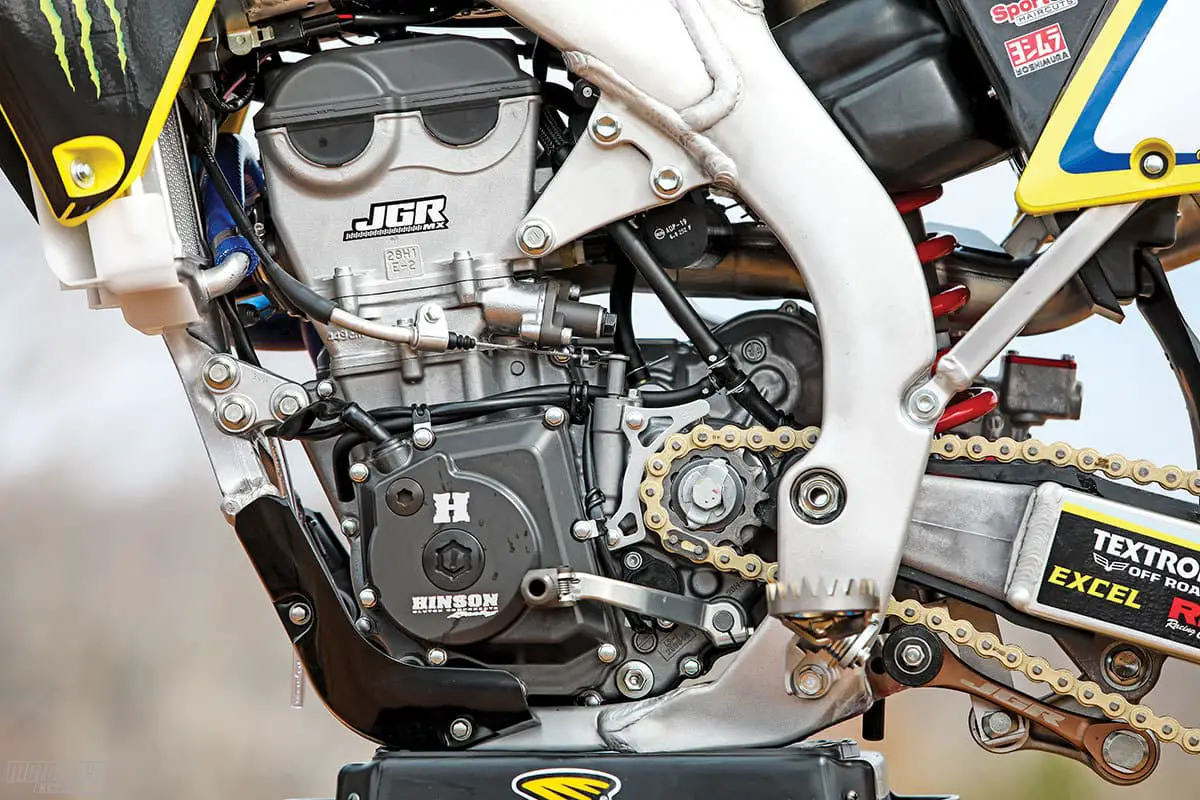
The majority of parts, engine work and suspension development used on the Suzuki are available to the public through the JGRMX Store. This also holds true for all the Yamaha YZ450F parts that were developed for the team during its blue period. JGRMX is currently in the process of making parts for all other brands, such as the CRF450 and KTM 450SXF. The JGRMX Store started as a simple engine and suspension hop-up shop devoted to the race team, but has evolved into a website (www.jgrmxstore.com) with hard parts being offered as well.
The guys over at Cycra had a brand-spanking-new RM-Z450 on their hands. It was decked out with new plastics but nothing else. Cycra decided to send it to JGR to get the benefit of the knowledge the race team had learned during the AMA Supercross season. The goal? Make it into a JGR race-team replica. Cycra knew that there were a few unobtanium factory parts that wouldn’t be offered to them, but they had solutions for those issues. Cycra had one caveat—the bike had to run on pump gas. This is where the MXA wrecking crew came into the picture. Cycra had its JGR RM-Z450 finished, but they needed someone to test it. Peick and Nicoletti were injured, and Justin Barcia was struggling with his own problems. So, Cycra asked the MXA wrecking crew to put the stamp of approval or kiss of death on its baby. MXA, Cycra and JGR have a strong relationship, and it is rooted in truth-telling. If we don’t like something, we are more than willing to roast it. So, we packed our test-crew bags and headed for the Joe Gibbs compound in North Carolina to put the JGRMX/Cycra RM-Z450 through its paces.

Since it was imperative to Cycra that the engine run on pump gas, JGRMX engine tuner John Mitchell, better known as “Bundy,” had to throttle back on some of the mods that are done on the race-team bikes; however, things like the Webcam camshafts, Xceldyne valve springs, Carrillo rod, Xceldyne DLC-coated buckets and JE piston (replete with DLC coated pin) were installed. As with all their race engines, extensive time was spent porting and polishing the head. Additionally, JGR had the transmission pulled apart and sent over to JGR’s NASCAR shop for the REM coating treatment. This process strengthens the gears, reduces friction, improves shifting, lessens vibration and noise, and results in better overall transmission performance.
As for the suspension, the atrocious Showa SFF TAC air forks were transformed into a spring/air hybrid by JGRMX’s suspension tech Joey Bray. The hybrid TAC conversion kit throws the complexity of the TAC fork out the window and makes it as simple as pie. The conversion kit basically makes the SFF TAC air fork into a Showa SFF single-spring fork with the addition of an inner air chamber that gives you the initial feel of a coil spring, not the air pressure. The inner air chamber runs a very low 15 to 25 psi to help the modified fork feel better in the bottom of the stroke while still allowing it to ramp up the stiffness to resist bottoming.
One of the most technical features of the bike was the GET ECU. The mapping was customized by JGRMX for the RM-Z450 and offers a laundry list of engine-tuning abilities, along with a launch-control feature. The GET device has a 1–10 LED display that is mounted on the front fender. By pressing the JGRMX handlebar-mounted button, you can detune the power in 10 increments. We know you’re thinking: “When would we want to make the bike slower?” Here is an example: if you’re riding a hardpacked, slick track with a high-horsepower, hard-hitting powerplant, it will be extremely hard to control wheelspin in those conditions. In that case, you dial the GET map tool back. On the other hand, when track conditions are deep and loamy, you will want more power to pull you through, thus you would set the GET system at full power.
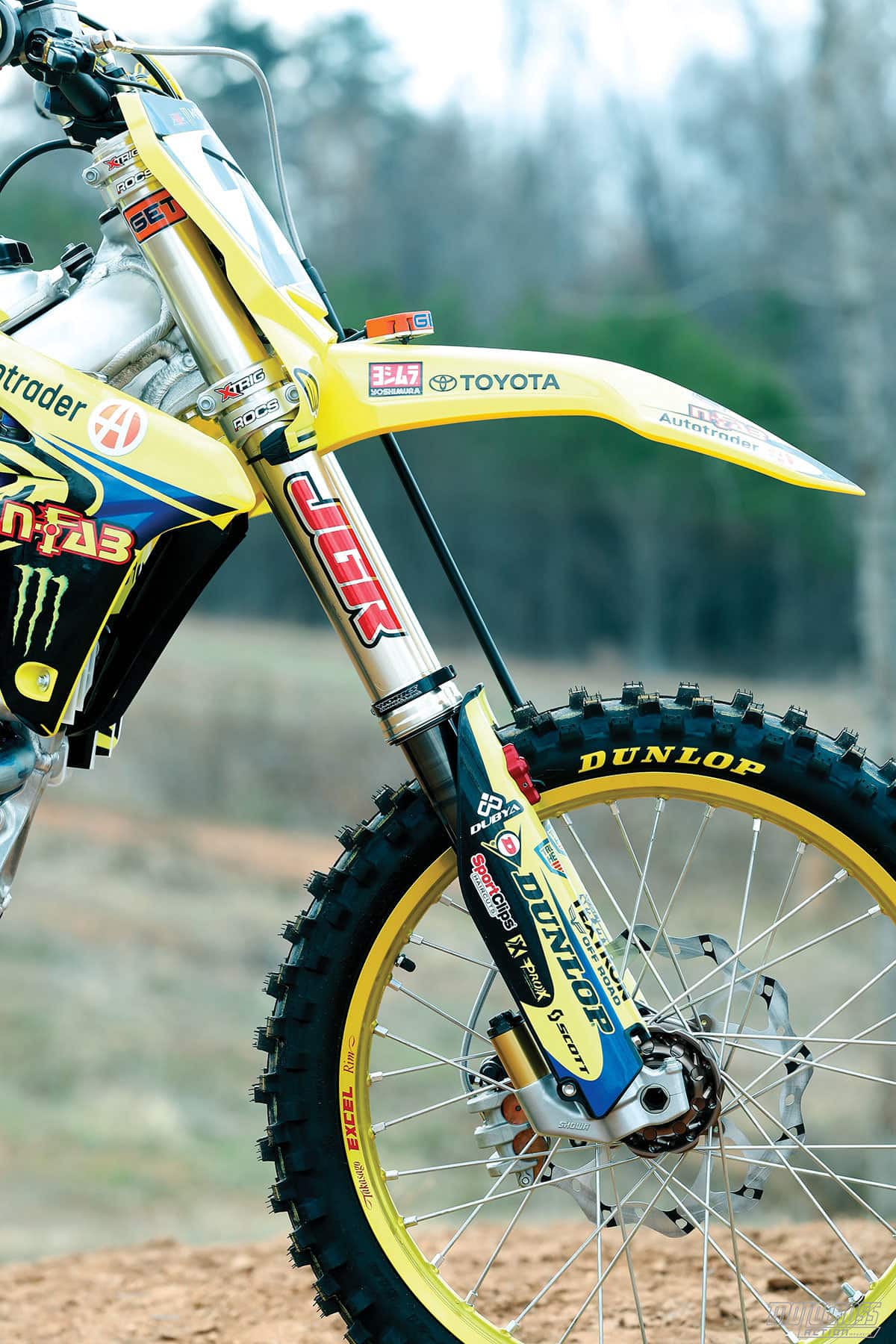
As for launch control, the GET system is engaged by holding the JGR button down until the LED fender displays flashes. You can then tune the power delivery as well as the amount of time it is engaged off the start before returning back to the original map. The JGR team riders had their launch controls set at 2 seconds.
MXA STAMP OF APPROVAL
MXA has access to a very private test track in North Carolina that has a little bit of everything mixed in—sand, hardpacked, loam and a variety of motocross- and Supercross-like sections. MXA test rider Dennis Stapleton’s first response to the JGR bike was, “This is the best overall RM-Z450 package I have ever ridden.” Dennis liked the easy-to-ride characteristics of the stock engine but knew it was too slow to keep up with the latest white, green, red, blue and orange 450s. The curve of the stock powerband delivered good low-to-mid horsepower but took a big dip before a late burst and early sign-off. The JGRMX-tuned engine got to the sweet spot of the power curve quickly, and after the sweet spot, where you would have had to shift with the stock engine, the JGR powerplant hit the afterburners on the top end and revved to the moon. Was it factory-bike fast? Yes, it was fast, but probably not in the league of the works engines. Still, it would be the perfect engine for an AMA privateer on a budget or a local up-and-coming Intermediate. Thanks to the pump-gas setup, it will last 40 to 50 hours without a rider having to worry about engine parts. It is good enough to race an AMA National, and even better for 40-year-old racers to use at the World Vet Championships.

Coming to terms with the GET system took considerable time. With the GET system set on full power, the JGR engine was too aggressive for every part of the track. The MXA wrecking crew has considerable experience with the GET system, but not on a Suzuki RM-Z450. So, we started with what we knew from our Yamaha and Husqvarna saddle time and turned the dial to number 4. This got us closer to a powerband that was best suited to the North Carolina track. Eventually, we found the sweet spot, the spot where the power delivery was usable but still had more than enough power when we needed it—on setting number 3. It should be noted that setting number 10 is fully detuned, and when the dial is turned to number 10, the RM-Z450 can hardly get out of its own way. Conversely, on setting 1, the RM-Z450 was too quick, too jumpy and too aggressive to turn fast lap times. The difference between the GET numbers is noticeable. We settled on 3, but you may prefer 5.
“IT WAS THE BEST OF BOTH WORLDS—AIR AND STEEL WORKING TOGETHER IN HARMONY.”

It would be hard for forks to get much worse than the stock RM-Z450 SFF TAC forks. They just don’t move. No surprise, because they didn’t move in 2016, and Suzuki didn’t make a single change to them for 2017. They would be perfect for hitting Supercross triples and clicking up to fourth to go through massive whoops, but they are not good for actually hitting motocross-style bumps. The biggest complaint about air forks in general is that they don’t follow the ground as well as spring forks. So, JGR’s Joey Bray took the air forks and converted them to coil-spring forks—with an air booster. On the track, the MXA test riders felt the forks were on the soft side for a Pro. They absorbed every nook and cranny, but they were too soft initially and would bottom on any of the big jumps. Joey Bray denied MXA’s request to go stiffer on the compression damping. Instead, he added a small amount of air to each fork leg. Joey was confident that the forks would not bottom now, no matter how the bike landed. He was right. The addition of the air ramped up the stiffness at the bottom of the stroke, so the bottoming resistance was greatly increased. It was the best of both worlds—air and steel working together in harmony. The forks tracked the ground well and didn’t bottom on the hard hits.
As for the shock, at first the MXA test riders complained that the rear felt too high and put too much weight on the forks, giving the bike a stinkbug feel. Joey had installed an adjustable JGR shock link on the RM-Z450, so he dropped the rear down by changing the adjustable inserts. After the rear end was dropped, we felt the bike was better balanced and worked well with the shock.
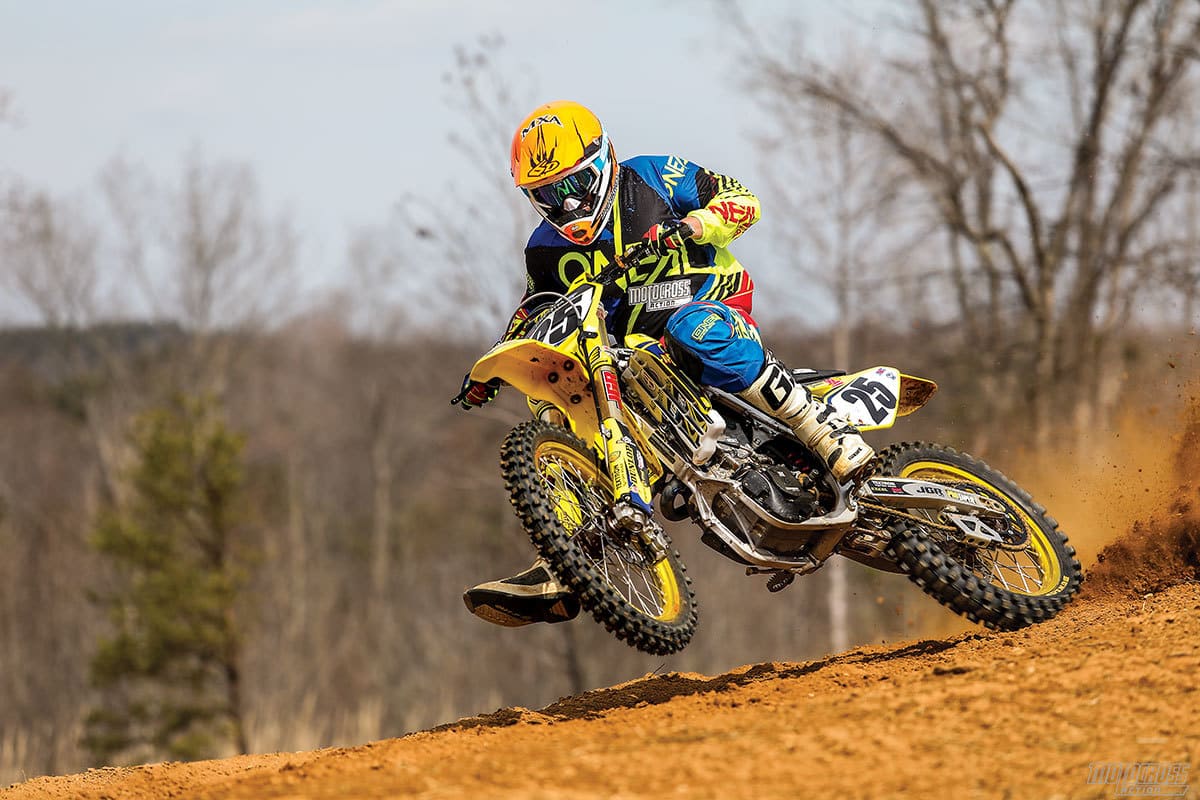
The Cycra/JGRMX RM-Z450 did not lose its baby fat—that would have cost thousands of dollars in titanium and carbon fiber parts—but it was transformed into a bike that showed its full potential. It was faster, handled better, offered working suspension and was a blast to ride.






Comments are closed.